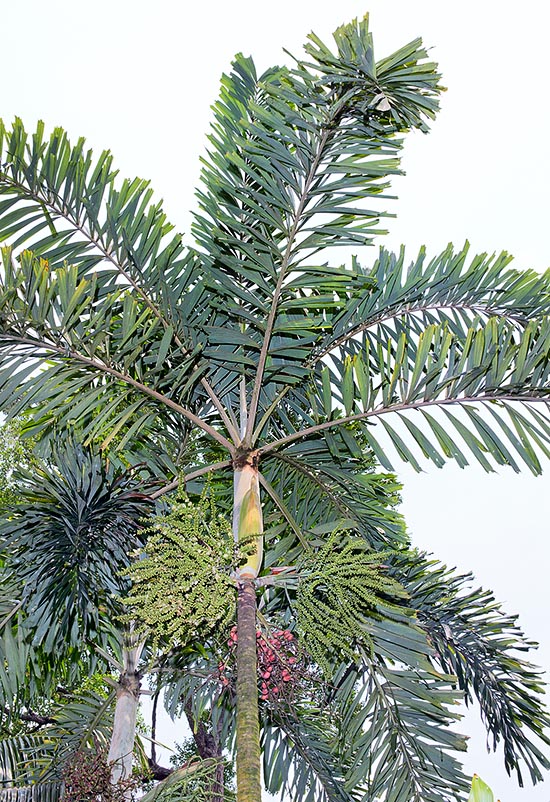Family : Arecaceae

Text © Pietro Puccio

English translation by Mario Beltramini

The Normanbya normanbyi is a vulnerable species endemic to north-eastern Queensland © Giuseppe Mazza
Genus and species are honoured to the English politician George Augustus Constantine Phipps Normanby (1819-1890) who was Governor of Queensland (1871-1874).
Common names: black palm (English).
The Normanbya normanbyi (W.Hill) L.H.Bailey (1930) is an unarmed monoecious species with solitary erect stem, smooth, with bulbous base crossed by vertical fissures, up to about 20 m tall with a diameter of 15-20 cm, of greyish colour tending to turn always darker with age, and on which are visible the rings trace of the junction of tha fallen leaves.
The leaves, on short petiole covered by a thick whitish tomentum and brown scales, are pinnate, curved, 2-3 m long, with rachis covered by thick brown scales and pinnules that in the adult plants are arranged irragularly and at different angles around it, subdivided up to almost the base in 7-9 parallel segments, 30-50 cm long and 1-3 cm broad, with truncated and toothed apex, of dark green colour above, covered by thick and tiny bluish white scales below. The foliar base wraps completely the stem per a length of 0,6-1 m forming a sort of a tubular capital, just enlarged at the base, of ash grey colour with brownish apex.
The inflorescences, initially enclosed in two about 30 cm long bracts, generate under the leaves (infrafoliar) on short peduncle, are drooping, ramified, 60-90 cm long, with whitish unisexual flowers arranged in triad (a female flowers between two male ones) in the lower part, whilst in the terminal part are present only male flowers solitary or in couple. The fruits are ovoid with pointed apex, pink to reddish brown when ripe, 4,5 cm long and of 3 cm of diameter, with 0,5-1 mm broad fibres present in the mesocarp, containing one seed only. The first leaflet is bifid. It reproduces by seed, previously kept in lukewarm water for two days, that if fresh germinates in 2-3 months in aerated and draining loam maintained humid at the temperature of 24-26 °C.
Particularly elegant palm because of the thin stem and the crown of feathery looking leaves, of remarkable landscape value as isolated specimen, in group or in line at the borders of roads and alleys, suitable to tropical and humid subtropical climates, its cultivation may be tried in the milder temperate ones where temperatures around the 0 °C are exceptional and very short lasting events. Fast growing, in optimal cultivation conditions, requires well drained deep soils and rich of organic substance, slightly acidic or neutral, maintained constantly humid, and semi-shaded position during the first years of life, then in full sun. In the climates having drought periods, needs regular waterings, especially when young, and takes advantage from regular fertilizations.
The interior of the stem, hard and blackish, is utilized by the aborigines for realizing various handicrafts and in in the constructions. The species is inserted in the red list of the IUCN (International Union for the Conservation of Nature) as “vulnerable” (at risk of extinction in the wild).
Synonyms: Areca normanbyi (W.Hill) F.Muell. (1874); Cocos normanbyi W.Hill (1874); Ptychosperma normanbyi (W.Hill) F.Muell. (1880); Drymophloeus normanbyi (W.Hill) Benth. & Hook.f. ex Becc. (1885); Normanbya muelleri Becc. (1885); Saguaster normanbyi (W.Hill) Kuntze (1891).
→ For general notions about ARECACEAE please click here.
